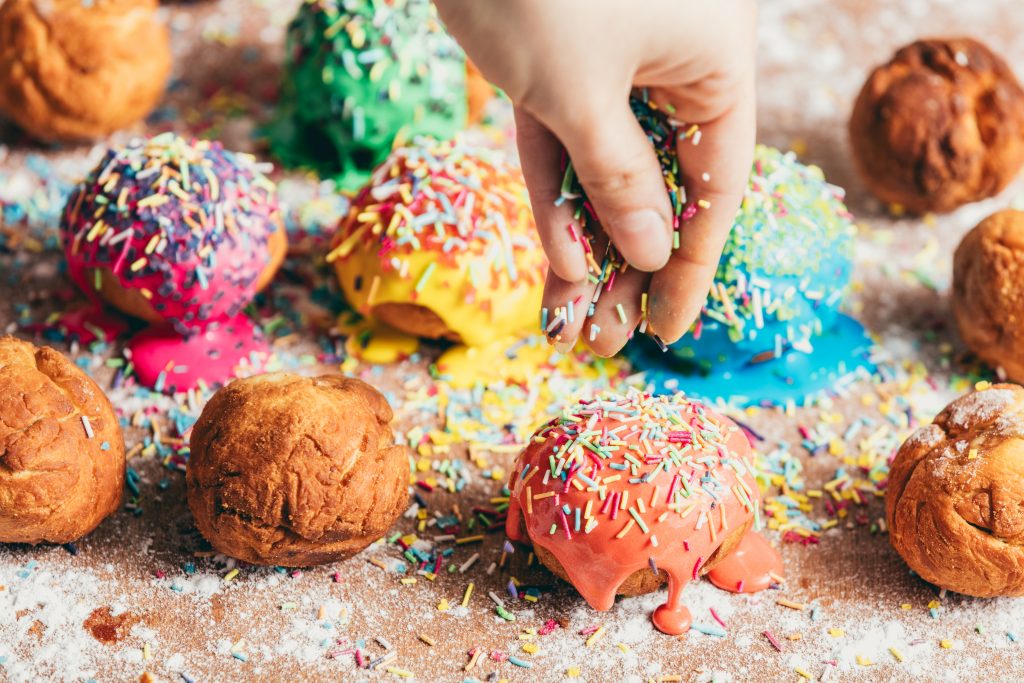If there’s one universal truth every child seems to know, it’s that sprinkles have the magical ability to make anything better. These tiny, colorful confections bring a burst of joy and a splash of whimsy to anything they touch, whether it’s a cupcake, a slice of cake, or a scoop of ice cream. But the charm of sprinkles doesn’t stop there; they’re a global delight, used in a variety of ways around the world.
“Happiness is life served up with a scoop of acceptance, a topping of tolerance, and sprinkles of hope—although chocolate sprinkles also work.” — Robert Breault
Sprinkles Day is a celebration of these cheerful decorations, inviting us to explore the many variations and uses of sprinkles across different cultures. It’s a day to indulge in the simple pleasure they bring and perhaps try out some new, sprinkle-laden treats.
Like many delightful things, sprinkles have an interesting history that traces back to their origins. They were originally known as nonpareils, a term that dates back to the 18th century. However, there’s evidence suggesting that these tiny sweets might have been around even earlier, adding a touch of sweetness and beauty to desserts for centuries.
Since their humble beginnings, sprinkles have gained global popularity, taking on different forms, flavors, and names. In Holland, they’re called hagelslag and are often sprinkled on buttered bread. In Philadelphia and Boston, you might hear them referred to as jimmies. In Indonesia, they go by the name meses, and in Belgium, they’re whimsically known as muizenstrontjes, or “mouse droppings.”
One particularly charming use of sprinkles is found in Australia and New Zealand, where they’re used to make fairy bread—a simple but beloved treat made by spreading butter on white bread and covering it with colorful sugar sprinkles. It’s a childhood favorite at parties and a testament to the joy that sprinkles can bring with just a few simple ingredients.
Sprinkles Day is all about embracing the playful, colorful spirit of these tiny treats. It’s a chance to learn about different types of sprinkles from around the world, experiment with new recipes, and, most importantly, bring a bit of extra joy to the day. So go ahead—grab a jar of sprinkles, add them to your favorite dessert, and let the fun begin!
Sprinkles add a touch of fun and whimsy to any treat, and their rich history and global variations make them even more delightful! Here are 20 fun facts about sprinkles:
- Ancient Origins: Sprinkles have been around for centuries, with their earliest known form being “nonpareils,” which dates back to the 18th century. The name “nonpareil” means “without equal” in French.
- Not Just for Looks: While sprinkles are often used for decoration, they also add a subtle crunch and sweetness to desserts, enhancing both texture and flavor.
- Different Names Worldwide: Sprinkles go by many names around the world. They’re called “hagelslag” in the Netherlands, “jimmies” in some parts of the United States, “meses” in Indonesia, and “hundreds and thousands” in the UK and Australia.
- Hagelslag Sandwiches: In the Netherlands, “hagelslag” is a popular topping for buttered bread, often enjoyed as a breakfast or snack.
- Rainbow Colors: The vibrant colors of sprinkles are made from food-grade dyes. However, you can also find naturally colored sprinkles made from plant extracts like beetroot and turmeric.
- Fairy Bread: In Australia and New Zealand, “fairy bread” is a beloved party treat made by spreading butter on white bread and topping it with rainbow sprinkles.
- Not Technically Candy: Sprinkles are classified as a “decorative confectionery” rather than a candy because they are primarily used for decoration rather than eaten on their own.
- Jimmies Origin: The term “jimmies” is often used in the northeastern United States, particularly in Philadelphia and Boston. The origin of the name is unclear, but one theory suggests it came from the Just Born candy company, which started calling them “jimmies” in the 1930s.
- Chocolate vs. Rainbow: Chocolate sprinkles are usually made from a different base than rainbow sprinkles, often including cocoa powder or chocolate, giving them a distinct flavor.
- Sprinkle Shapes: While most sprinkles are tiny rods or spherical, you can find sprinkles in various shapes like stars, hearts, flowers, and even themed shapes like unicorns or snowflakes.
- Kosher Sprinkles: Many sprinkle manufacturers offer kosher-certified sprinkles, making them suitable for a variety of dietary restrictions.
- Edible Glitter: Some sprinkles are made with edible glitter, giving desserts an extra sparkle and shine.
- Sugar-Free Options: For those watching their sugar intake, sugar-free sprinkles are available, made with sugar substitutes like erythritol or stevia.
- Melting Point: Sprinkles have a high melting point, which is why they maintain their shape even when added to hot desserts like donuts or cupcakes.
- Sprinkles in Ice Cream: Sprinkles are a classic ice cream topping, and some ice cream shops even offer “sprinkles galore,” where the entire scoop is rolled in sprinkles.
- Sprinkle Confetti: Some sprinkles are designed to dissolve in liquid, creating a “confetti” effect when added to drinks or desserts.
- Sprinkle Art: Sprinkles have been used by artists like Joel Penkman and Tisha Cherry to create intricate and colorful artwork, proving they’re not just for eating!
- Celebratory Symbol: In many cultures, adding sprinkles to desserts symbolizes celebration, joy, and festivity, making them a popular choice for birthdays, weddings, and other special occasions.
- World Record: The Guinness World Record for the most sprinkles on a single cupcake is held by Georgetown Cupcake in Washington, D.C., with over 250,000 sprinkles!
- DIY Sprinkles: You can make your own sprinkles at home by piping royal icing or melted candy melts into thin lines, letting them harden, and then cutting them into tiny pieces.


